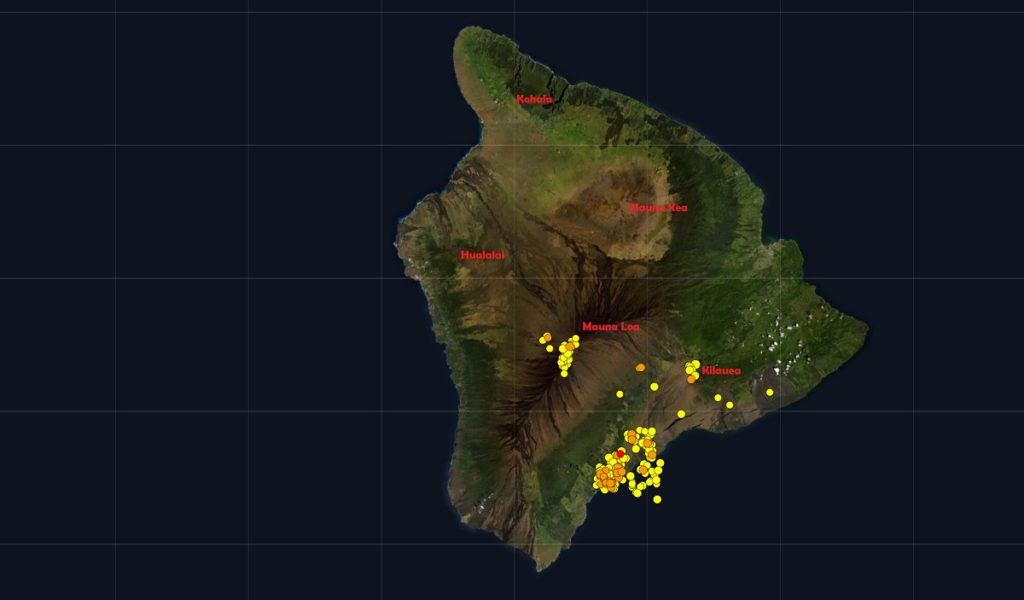
More than 200 earthquakes have rattled Hawaii over the last 7 days, according to USGS, making geologists ponder: will all of this earthquake action trigger an eruption at Mauna Loa, the world’s largest active volcano, or will an eruption event at the volcano trigger a mighty quake?
Mauna Loa is not erupting and there are no signs of an imminent eruption at this time. However, Mauna Loa continues to be in a state of heightened unrest as indicated by increased earthquake activity and inflation of the summit. According to Hawaiian Volcano Observatory (HVO) scientists with the USGS, the current unrest is most likely being driven by renewed input of magma 2-5 miles beneath Mauna Loa’s summit.
During the past 24 hours, HVO detected 35 small-magnitude (below magnitude 3) earthquakes 2-3 miles below Mokuāʻweoweo caldera and 4-5 miles beneath the upper-elevation northwest flank of Mauna Loa. Both of these regions have historically been seismically active during periods of unrest on Mauna Loa.
Meanwhile, near the town of Pahala on Mauna Loa’s southeastern slopes, aftershocks continue from a damaging earthquake that struck the area on Friday. According to USGS, over the past 48 hours, there have over 150 aftershocks in the Pahala region. Of these, 20 were greater than magnitude 2.5 and 4 have been greater than magnitude 3 seismic events.
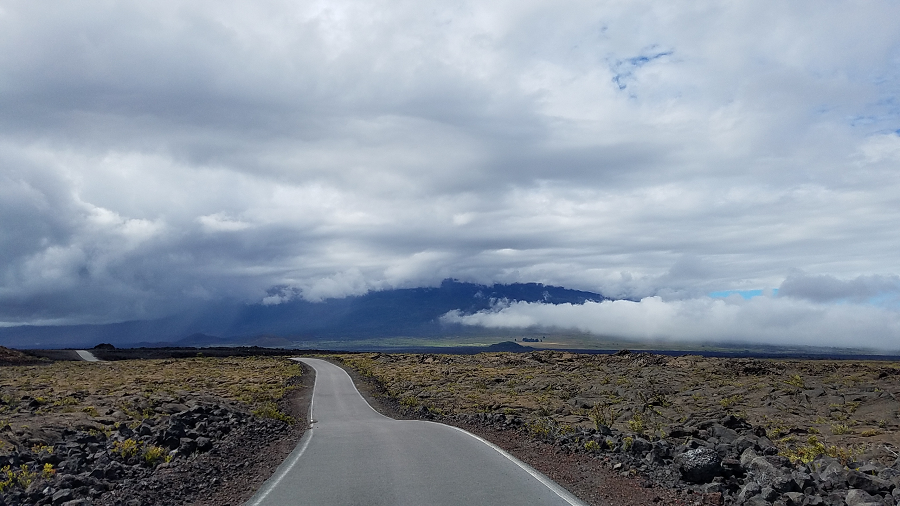
Overall, earthquake activity has been on a considerable upswing in recent weeks, prompting authorities to close public access to the summit of the Mauna Loa volcano on October 6. Earthquake activity has been increasing from 5-10 earthquakes per day since June 2022, to 10-20 earthquakes per day in July and August, and reaching approximately 40-50 earthquakes per day over the first two weeks of the month. Peak numbers of over 100 earthquakes per day occurred on September 23rd and 29th.
“Due to elevated seismic activity on Mauna Loa and as a precautionary measure, Hawai‘i Volcanoes National Park is closing the Mauna Loa summit backcountry until further notice,” cautioned the National Park Service in a press release announcing the closure of the summit area. “Mauna Loa Road and the Mauna Loa Lookout at 6,662 feet elevation remain open to the public.”
Scientists are trying to determine what will happen next.
HVO geophysicist Jefferson Chang said, “It is a bit of a chicken or egg problem, whether these large, shallow earthquakes under volcanoes lead to eruptions, or if it is the magma shifting stresses along faults that trigger earthquakes. These are two end-member hypotheses, and in reality, it is most likely a combination of both. Earthquakes and volcanic eruptions go hand-in-hand. ”
Scientists at HVO look at many different monitoring streams to document changes in Mauna Loa’s behavior. Some of these changes may alert scientists when an eruption is more likely. Large shallow earthquakes are one of the indicators that move the probability of an eruption of Mauna Loa from “not necessarily” to “highly likely”. For example, a magnitude-6.7 earthquake happened a few months before the last eruption of Mauna Loa in 1984. The 1950 eruption was also preceded by a large earthquake, but only 2 days prior to the onset of the eruption. But on the flip side, a giant earthquake, such as 1975’s 7.7 magnitude event in Kalapana, led to no change in eruption activity on the island.
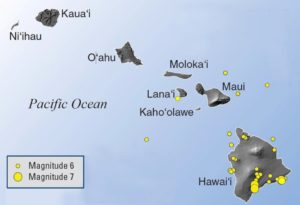
“Large shallow earthquakes are not just a potential precursor to volcanic eruptions, but can be a disaster on their own,” said Chang. “Damage done by large earthquakes can be mitigated to reduce the hazards and risks associated with violent shaking.
Many earthquakes have struck Hawaii over the years, creating significant damage and loss of life –even in the absence of a volcanic eruption. According to USGS, since 1868, there have been more than 30 magnitude 6.0 or greater seismic events in the islands, most of which have impacted the Big Island of Hawaii.
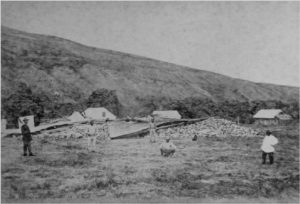
The largest earthquake to strike Hawaii struck in the Ka’u District in the southern portion of the Big Island on April 2, 1868. The estimated 7.9 magnitude event was equivalent in size to the 1906 San Francisco earthquake in California. While “extremely violent shaking” was felt in the southern portions of Hawaii’s Big Island, it was felt across most islands in the Hawaiian Island chain. Damage was very heavy across Hawaii’s south coast; moderate damage was also reported across Maui.
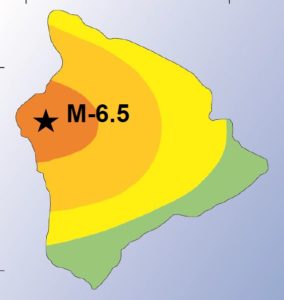
The destructive quake toppled stone walls and homes, opened ground cracks, and was severe enough to throw people off their feet. The quake generated a 60′ high tsunami along the Ka’u and Puna coastline, killing 46 people there. Multiple landslides were triggered, including one in Ka’u’s Wood Valley, where an additional 31 people died. Despite the intensity of the quake, there were only short-lived eruptions at both Mauna Loa and Kilauea Volcanoes in Hawaii.
On October 5, 1929, an estimated magnitude 6.5 event struck the western portions of Hawaii near the Hualalai Volcano. According to USGS, more than 6,200 foreshocks and aftershocks rattled the area. Homes, water tanks, stone wall fences, and roadways were damaged in Western Hawaii, leaving many people to camp outside during the swarm over fears their homes would collapse in on them.
On April 26, 1973, another violent earthquake struck Hawaii just north of Hilo. That magnitude 6.2 event generated more than $5.75 million in damages at the time, with water and electric service disrupted and homes and businesses damaged. Rockslides triggered by that quake blocked roads. At least 11 injuries were reported in the communities of Waimea and Hilo on Hawaii Island.
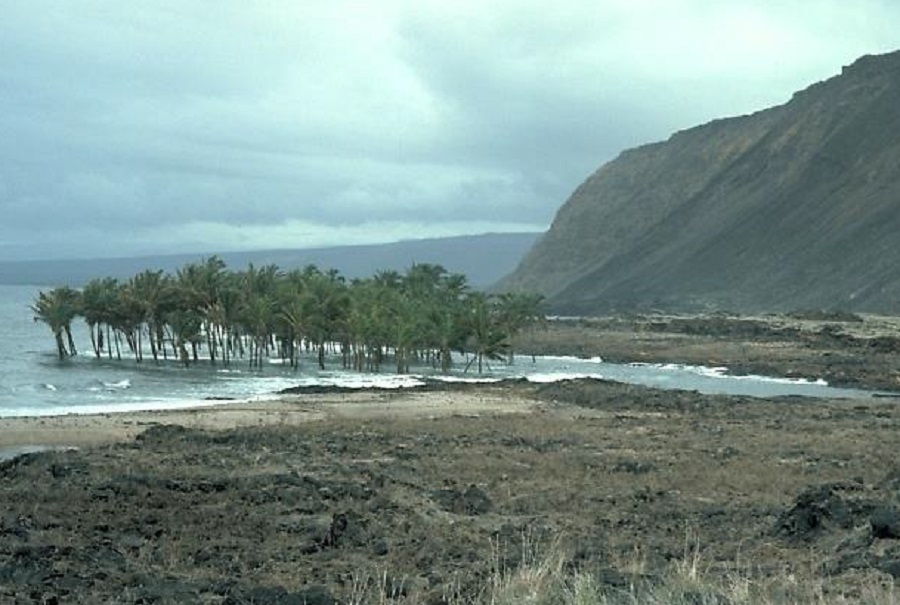
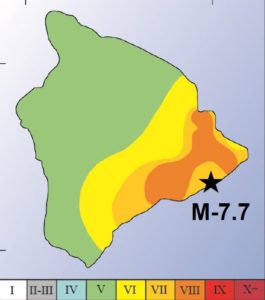
On November 29, 1975, another violent magnitude 7.7 earthquake struck the Puna district, creating significant damage and a lethal tsunami. Roads cracked open while homes shifted off of foundations. The tsunami, which was up to 48 feet in height in some locations, caused extensive damage to the island’s south coast. At Halape, two campers died and 19 others were injured when the tsunami wave swept over them. Due to the intensity of the quake, the coastline subsided by as much as 11′ during the quake, submerging a coastal coconut grow into the ocean there.
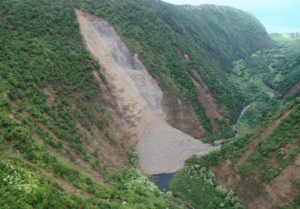
In October 2006, a pair of severe earthquakes struck the northwest region of Hawaii’s Big Island. Minutes after a magnitude 6.7 event at Kiholo Bay, a magnitude 6.0 earthquake struck off-shore of Mahukona on October 15, 2006. Together, these earthquakes produced significant damage across Kawaihae, Waikoloa, Waimea, and Kohala. Boat harbors, homes, bridges, and even a resort was badly damaged in the earthquake. The Mauna Kea Beach resort, an upscale resort on the South Kohala Coast, was shut down to make repairs and retrofits after engineers found the quake left the resort property unstable. More than $200 million in damages was caused by the earthquake pair.
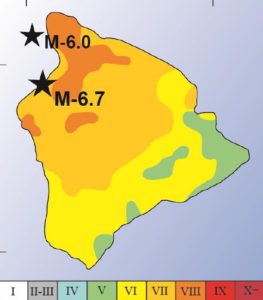
The destructive 2006 earthquake didn’t lead to a change in volcanic activity on the island, but a powerful quake in 2018 did.
On May 4, 2018, a violent 6.9 magnitude earthquake unfolded in the Puna District. Felt throughout the state, the event lead to structural damage in Hilo and Puna districts. It was the largest earthquake to strike Hawaii since the 1975 event. But news of the quake was overshadowed by the largest Kilauea Lower East Rift Zone eruption in more than 200 years, which had multiple fissures ejecting lava in populated portions of east Hawaii.
Scientists aren’t sure if the increasing volume of earthquakes at Mauna Loa will lead to an eruption. Or if the inevitable eruption will trigger major earthquakes on the Big Island.
Mauna Loa last erupted in 1984 and started with a seismic swarm. At 10:55 pm on March 24, the rate of earthquakes picked up significantly after a period of elevated earthquake activity. Instead of dozens of earthquakes a day, earthquakes were occuring 2-3 times per minute. By 11:30 pm, strong seismic tremor begun, indicating that magma was moving underground and getting close to the surface. A short time later, at 1:30 am on March 25, lava erupted from the volcano’s summit.
HVO research geophysicist Ingrid Johanson says, “The rapid onset of extreme unrest leading to eruption in 1984 is typical of the Mauna Loa eruptions that have been observed in the last two centuries. In addition to rapid onset, eruptions that migrate down either of Mauna Loa’s rift zones tend to be high volume and resulting lava flows can move quickly from their eruptive vents downslope toward the ocean.”
Mauna Loa’s current episode of unrest began in late 2014 with an increase in the rates of inflationary deformation and seismicity. These rates waned in 2017-2018, but began increasing again in 2019 and have remained somewhat steady since then, with earthquake rates of about 20 per day. A noticeable seismic swarm occurred from late January through mid-April 2021 and was accompanied by changes by ground surface tilt recorded by a summit tiltmeter. This was an unprecedented observation that indicated magma had been getting closer to the surface. Another short swarm and tilt event was observed in early August 2022.
On September 22, 2022, the volume of earthquakes jumped from 20 per day to 100+ per day.
“This uptick in activity is a good reminder to be prepared for a volcanic eruption, whether you live on the flanks of Mauna Loa or anywhere else on the Island of Hawaiʻi,” Johanson said.
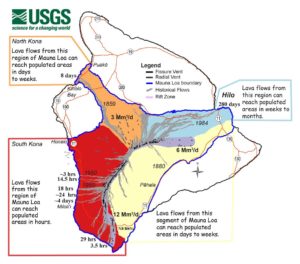
Today, Hawaii County Civil Defense echoed that message with an update spread on the island at 12 noon local time. “The U.S. Geological Survey’s Hawaiian Volcano Observatory reports that earthquake activity continues on Mauna Loa Volcano. The Advisory alert status has not changed and Mauna Loa is not showing signs of an imminent eruption,” the Civil Defense bulletin said. “Your Civil Defense Agency is closely monitoring the situation and in coordination with the Hawaiian Volcano Observatory will notify you of any changes that may affect your safety.”
There will be destructive earthquakes on Hawaii Island and an eruption of the world’s largest active volcano, Mauna Loa, is likely in the not-so-distant future. But precisely when these events will happen and if one will trigger the other remains beyond the understanding of science geologists have today.